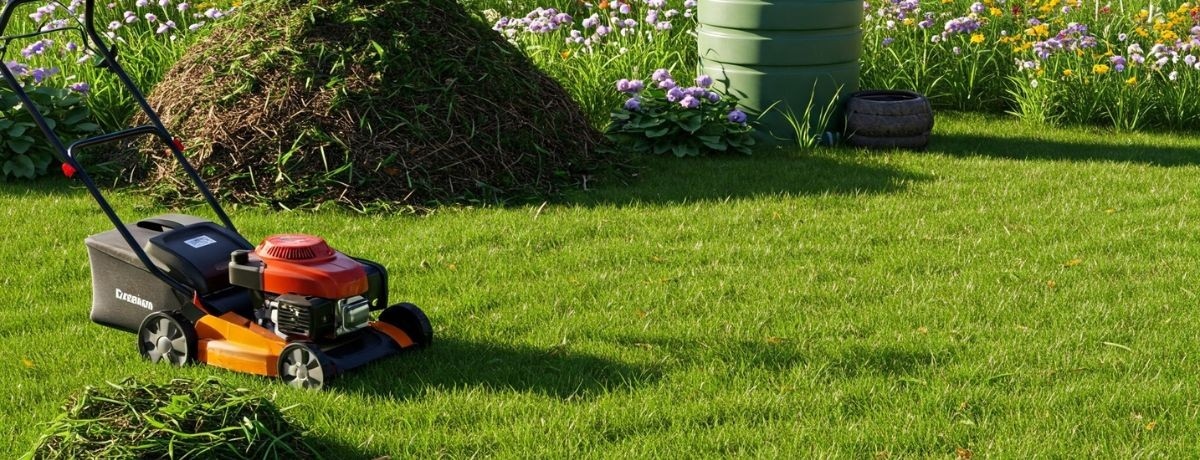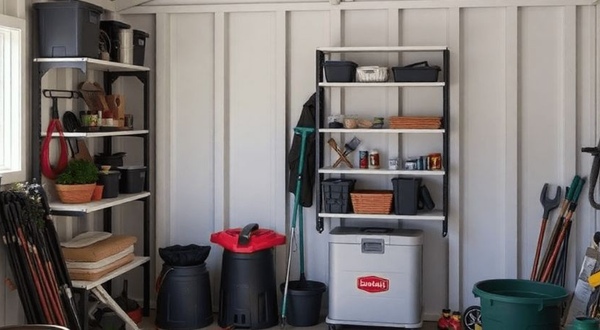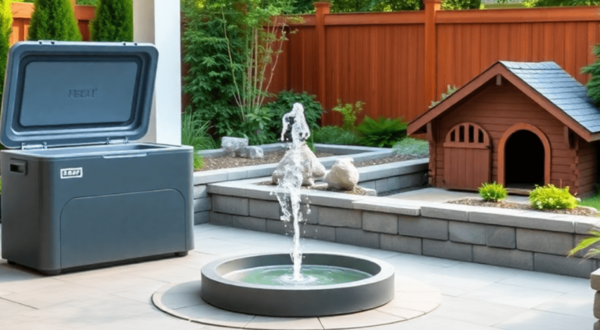
Sustainable lawn care practices in Canadian homes are crucial for maintaining eco-friendly outdoor spaces. By implementing environmentally sound techniques, homeowners can contribute to a healthier environment while enjoying a lush and vibrant garden. These practices not only benefit the local ecosystem but also promote sustainable living for future generations.
A key component of sustainable lawn care is using energy-efficient equipment. For instance, a Worx 40V 21 In. Push Lawn Mower offers an eco-friendly alternative to traditional gas mowers, featuring a 3-in-1 functionality that allows for mulching, bagging, or rear side-discharge.
Moreover, maintaining a well-trimmed lawn is essential for its health and appearance. The Worx 20V Power Share GT Revolution 12" String Trimmer not only makes trimming easier but also converts almost instantly into an in-line wheeled edger or mini-mower for a professional-looking lawn.
In addition to using efficient equipment, it's important to adopt practices that minimize harm to the environment. This includes pest control methods that are less harmful to beneficial insects and the overall ecosystem. For example, using a Sorbo mosquito zapper can help manage mosquito populations without resorting to harmful chemicals.
Furthermore, different tools can be used for various tasks in the garden. The Worx 40V Nitro Cordless Attachment 15" String Trimmer is perfect for those hard-to-reach areas, while the Worx 20V 13” Grass Trimmer/edger/mini-mower provides versatility in maintaining your garden.
By embracing these sustainable lawn care practices and utilizing efficient tools, Canadian homeowners can create beautiful outdoor spaces that are not only aesthetically pleasing but also environmentally friendly.
In Canada, adopting sustainable practices for lawn care is essential. This includes using phosphorus-free fertilizers to maintain healthy soil and water systems. Phosphorus runoff from traditional fertilizers can lead to water pollution in rivers and lakes, causing harmful algal blooms. By opting for phosphorus-free alternatives, homeowners can protect local water sources and aquatic ecosystems.
Another important aspect of lawn care is the application of organic or natural fertilizers. These fertilizers, derived from natural sources like compost, manure, or seaweed, provide essential nutrients to the soil without introducing harmful chemicals. They promote soil health, microbial activity, and long-term fertility.
One effective method in organic lawn maintenance is topdressing with compost. This practice involves spreading a layer of compost over the lawn surface to enrich the soil structure, enhance moisture retention, and encourage beneficial microorganisms. Topdressing reduces compaction, promotes root growth, and minimizes reliance on synthetic fertilizers.
By adopting these sustainable feeding practices, Canadian homeowners can nurture lush green lawns while safeguarding the environment for future generations. However, maintaining such lawns requires proper tools and equipment. From high-quality lawn mowers to efficient hedge trimmers, having the right gear makes a significant difference. Additionally, utilizing leaf blowers for debris clearance or investing in robust garage storage solutions for your gardening tools can further enhance your outdoor experience.
Mulching and recycling yard waste are important for sustainable lawn care. They have a direct impact on soil health and the balance of ecosystems in Canadian homes.
Moisture Retention: Applying mulch made from shredded leaves, grass clippings, or small branches helps retain soil moisture by reducing evaporation. This lowers the need for frequent watering, supporting water conservation efforts. Weed Suppression: A thick layer of organic mulch blocks sunlight from reaching weed seeds, reducing their germination and growth without relying on chemical herbicides. Temperature Regulation: Mulch insulates soil against extreme temperature fluctuations, protecting grass roots during cold Canadian winters and hot summer days.
Recycling yard waste such as fallen leaves, pruned branches, and grass trimmings as mulch around garden beds offers multiple environmental benefits:
Waste Reduction: Diverting yard debris from landfills minimizes methane emissions associated with organic waste decomposition under anaerobic conditions. Enhancing Biodiversity: Organic mulches create habitats for beneficial insects and soil organisms, which contribute to pest control and nutrient cycling. Nutrient Cycling: As mulch decomposes, it returns valuable nutrients to the soil, reducing reliance on synthetic fertilizers.
Recycling yard waste instead of bagging it up encourages:
Improved Soil Structure: Organic matter from mulched materials increases soil porosity and aggregation, allowing better air and water movement. Erosion Control: Mulch layers protect topsoil from wind and rain erosion by providing a physical barrier. Microbial Activity: Decomposing organic matter fosters diverse microbial populations essential for nutrient availability and plant health.
Homeowners can invest in tools like mulchers or tumbling composters to efficiently process yard waste onsite. Brands specializing in premium outdoor living products often provide equipment designed for ease of use and durability suited to Canadian climates. For instance, the Worx 20V Grass Trimmer and Blower Combo Kit is an excellent investment that keeps your yard clear of debris while ensuring neat edges.
Additionally, incorporating a storage shed can help store all your outdoor equipment safely.
Incorporating mulching and recycling practices supports a healthy lawn ecosystem while aligning with eco-friendly lawn care principles essential for preserving natural resources across Canada.
Proper mowing practices are essential for sustainable lawn care in Canadian homes. Maintaining the right mowing height promotes strong grass roots and reduces vulnerability to disease, enhancing the lawn's natural resilience.
Setting your mower blade to cut no more than one-third of the grass blade length at a time helps maintain optimal health. For most Canadian turfgrass varieties, maintaining a height between 2.5 to 3.5 inches encourages robust root systems. Taller grass shades the soil, helping retain moisture and suppress weed growth naturally.
Sharp mower blades deliver clean cuts that heal quickly, minimizing stress on grass plants. Dull blades tear grass, leaving ragged edges susceptible to disease and pests. Regularly sharpening blades enhances cutting efficiency and promotes a neat, healthy lawn appearance.
Deeper roots improve drought tolerance by accessing moisture stored deeper in the soil profile. They also stabilize soil, reducing erosion during heavy rains. Avoid frequent shallow mowing that encourages shallow roots vulnerable to environmental stresses.
Implementing these techniques aligns with 7 Sustainable Practices for Eco-Friendly Lawn Care in Canadian Homes by reducing water demand and chemical inputs while supporting natural lawn vitality.
To achieve the proper mowing height and encourage deep root growth, using advanced tools like the Worx 40V Grass Trimmer can be very beneficial. This tool is designed to cut efficiently while promoting healthy grass growth.
Additionally, maintaining sharp blades is crucial for optimal lawn health. Investing in high-quality lawn care equipment, such as the Worx 40V Cordless 13" Grass Trimmer, can significantly improve your mowing results.
Consistent attention to these mowing habits contributes significantly to building a resilient, eco-friendly outdoor living space that thrives season after season.
Utilizing rainwater for lawn watering is a sustainable practice that can significantly reduce the demand on freshwater sources. Installing rain barrels or cisterns allows homeowners to collect and store rainwater for later use in watering their lawns. This rainwater collection system can be an excellent addition to your outdoor space, while also serving as a decorative element.
Implementing simple strategies can help conserve water during lawn care routines. Watering the lawn early in the morning or late in the evening reduces evaporation loss and ensures that the water penetrates deeply into the soil, promoting healthier root systems for the grass. Using efficient tools like the Worx 40V Nitro Cordless Attachment String Trimmer can also aid in reducing water wastage by enabling precise trimming and edging.
By incorporating rainwater collection systems and adopting water conservation techniques, homeowners can effectively manage their lawn care practices while minimizing their environmental impact. Additionally, enhancing the aesthetic appeal of your garden with features like the Elementi Water Zen Fountain or the Dharma Fountain, can create a serene environment while promoting sustainability.
Protecting water quality in Canadian homes starts with thoughtful landscape design that includes no-maintenance zones near water bodies. These zones act as natural filters, intercepting pollutants such as fertilizers, pesticides, and sediment before they reach lakes, rivers, or streams.
The following are the benefits of no-maintenance zones:
Integrating native plant buffers into these zones enhances their effectiveness while supporting local ecosystems. Native plants are adapted to regional climate and soil conditions, requiring minimal irrigation or fertilization once established.
The following are the advantages of using native plants in buffer zones:
Examples of native plants suitable for Canadian buffer zones:
|
Plant Type Examples Benefits Grasses |
Bluejoint reedgrass, Little bluestem |
Dense roots for erosion control |
|
Shrubs |
Red osier dogwood, Highbush cranberry |
Provide cover and food for wildlife |
|
Wildflowers |
Black-eyed Susan, Wild bergamot |
Attract pollinators and improve soil health |
Establishing no-maintenance zones with native plants is a practical step toward sustainable lawn care. It safeguards waterways from harmful runoff while enriching your property's natural beauty. This approach complements other eco-friendly practices by reducing chemical reliance and promoting resilient outdoor spaces.
Integrated Pest Management (IPM) strategies in lawn care practices provide an effective, eco-friendly approach to managing pests while minimizing chemical inputs. IPM focuses on monitoring pest populations, identifying thresholds for action, and encouraging the presence of beneficial insects that naturally control harmful pests.
Reducing dependency on synthetic pesticides prioritizes both human health and environmental protection. Natural pest control methods stand out as safe alternatives. Examples include:
Adopting these techniques aligns with 7 Sustainable Practices for Eco-Friendly Lawn Care in Canadian Homes by fostering a balanced ecosystem within your yard. Minimizing chemical use protects waterways from contamination—a critical concern in Canadian environments where runoff can impact delicate aquatic systems.
Natural pest management integrates seamlessly with other sustainable lawn care methods, reinforcing the overall health and resilience of outdoor spaces. This approach contributes to maintaining premium outdoor living products' effectiveness by ensuring lawns remain lush and vibrant without relying on harsh chemicals.
In our quest for sustainable gardening, we can significantly reduce our water usage and support local wildlife by replacing traditional turf with native plants. This shift not only conserves water but also promotes biodiversity in our gardens. We can delve into these xeriscaping techniques for Canadian gardens which are specifically designed to minimize water usage.
Moreover, the use of permeable materials for hardscapes is another beneficial approach. These materials allow water to seep through, reducing runoff and promoting groundwater recharge. Integrating elements like water fountains, such as the Elementi Water Pagoda Fountain, can enhance the aesthetic appeal of these hardscapes while also providing a calming natural element to our outdoor spaces.
In addition to the previously mentioned eco-friendly practices, there are other ways you can make your lawn care routine more sustainable.
Consider using electric lawnmowers powered by renewable energy sources like solar or wind. These mowers operate quietly and produce zero emissions, making them an excellent choice for environmentally conscious homeowners.
For example, the Worx 24" Electric Hedge Trimmer is a great eco-friendly lawn care tool that reduces carbon emissions while efficiently trimming hedges and bushes.
Instead of using chemical-based pesticides or herbicides, opt for organic treatments made from natural ingredients. These alternatives are not only safer for the environment but also beneficial for your plants and soil.
Some effective organic treatments include:
By incorporating these additional eco-friendly practices into your lawn care routine, you can further reduce your environmental impact and contribute to a sustainable future.
By following the 7 Sustainable Practices for Eco-Friendly Lawn Care in Canadian Homes, you can create a healthier lawn and make a positive impact on the environment. These practices not only benefit your outdoor space but also help protect Canada's natural resources.
Creating habitat gardens for local wildlife is one way to do this. By transforming your yard into a sanctuary for pollinators, birds, and beneficial insects, you can promote biodiversity and support the balance of ecosystems. These habitat gardens:
Using sustainable methods for lawn care is another important step. This means reducing our dependence on chemicals, conserving water, and improving soil health. Every action we take towards eco-friendly practices contributes to the preservation of native ecosystems and shows our respect for nature.
When making decisions about lawn care, it's essential to prioritize choices that promote long-term resilience and environmental responsibility. By incorporating these techniques into your routine, you can ensure that your property thrives while also supporting larger ecological goals. This aligns with the values of premium outdoor living products and high-quality goods designed with sustainability in mind.


